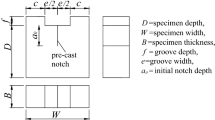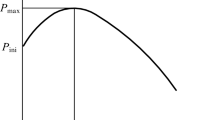Abstract
Double-K criterion is comprised of two fracture parameters: initial cracking toughness and unstable fracture toughness. Both parameters are derived from linear-elastic fracture mechanics principles and can be obtained through experiments in laboratories. A proposal for a RILEM recommendation of the standard testing methods for determination of double-K criterion for crack propagation in concrete has been put forward (Xu et al. in Mater Struct, 2021. 10.1617/s11527-021-01786-8). The significance and applicability of double-K criterion for predicting crack initiation, structure failure and crack stability in concrete structures are introduced. To determine the double-K fracture parameters, two testing methods which are wedge-splitting test and three-point bending beam test are recommended. The calculation methods of double-K fracture parameters and their corresponding theoretical basis are presented.







Similar content being viewed by others
References
Xu S, Li Q, Wu Y, Dong L, Lyu Y, Reinhardt HW, Leung CKY, Ruiz G, Kumar S, Hu S (2021) RILEM Standard: testing methods for determination of the double-K criterion for crack propagation in concrete using wedge-splitting tests and three-point bending beam tests, recommendation of RILEM TC265-TDK. Mater Struct. https://doi.org/10.1617/s11527-021-01786-8
Yang W, Zhao P, Wang H (2020) An overview of mechanics. Science Press, Beijing (in Chinese)
Bazant ZP, Kim JK, Pfeiffer PA (1986) Nonlinear fracture properties from size effect tests. J Struct Eng ASCE 112(2):289–307
Hillerborg A, Modeer M, Petersson PE (1976) Analysis of crack formation and crack growth in concrete by means of fracture mechanics and finite elements. Cem Concr Res 6(6):773–782
Jenq YS, Shah SP (1985) Two parameter fracture model for concrete. J Eng Mech ASCE 111(10):1227–1241
Reinhardt HW, Cornelissen HAW, Hordijk DA (1986) Tensile test and failure analysis of concrete. J Struct Eng ASCE 112(11):2462–2477
Karihaloo BL, Nallathambi P (1990) Effective crack model for the determination of fracture toughness (KsIc) of concrete. Eng Fract Mech 35(4/5):637–645
Refai TME, Swartz SE (1987) Fracture behavior of concrete beams in three-point bending considering the influence of size effects. Report no. 190, Engineering Experiments Station, Kansas State University
Bazant ZP, Oh BH (1983) Crack band theory for fracture of concrete. RILEM. Mater Struct 16(93):155–177
RILEM Technical Committee 50-FMC (1985) Determination of the fracture energy of mortar and concrete by means of three-point bend tests of notched beams, proposed RILEM draft recommendations. RILEM. Mater Struct 18(106):285–296
RILEM Technical Committee 89-FMT (1990) Determination of fracture parameters (KsIc and CTODc) of plain concrete using three-point bend tests, proposed RILEM draft recommendations. RILEM. Mater Struct 23(138):457–460
RILEM Technical Committee 89-FMT (1990) Size-effect method for determining fracture energy and process zone size of concrete, proposed RILEM draft recommendations. RILEM. Mater Struct 23(138):461–465
Pflug L (1979) Proceedings of 7th National Congress of the Italian Society for stress analysis, supplement, Cagliari, A.I.A.S., pp 5–26
Xu S (1988) The fracture mechanism of concrete. Ph.D. Thesis, Dalian University of Technology, Dalian, China (in Chinese)
Zandman F, Redner S, Dally JW (1977) Photoelasticcoatings. Iowa State University Press, Ames, Iowa
Xu S, Reinhardt HW (1999) Determination of double-K criterion for crack propagation in quasi-brittle materials, part I: experimental investigation of crack propagation. Int J Fract 98(2):179–193
John R, Shah SP (1986) Fracture of concrete subjected to impact loading. J Cem Concr Aggreg 8(1):24–32
Du JJ, Kobayashi AS, Hawkins NM (1989) An experimental–numerical analysis of fracture process zone in concrete fracture specimens. Eng Fract Mech 35(1/2/3):15–27
Maji AK, Shah SP (1989) Application of acoustic emission and laser holography to study microfracture in concrete. ACI Special Publication
Kaplan MF (1961) Crack propagation and the fracture of concrete. J ACI 58(5):591–610
Bascoul A, Kharchi F, Maso JC (1989) Concerning the measurement of the fracture energy of a macro-concrete according to the crack growth in a Three Points Bending Test on Notched Beams. In: Shah SP, Swartz SE (eds) SEM/RILEM international conference on fracture of concrete and rock, Houston, Texas, pp 396–408
Saouma VE, Barton CC, Gamaleldin NA (1990) Fractal characterization of fracture surfaces in concrete. Eng Fract Mech 35(1–3):47–53
National Development and Reform Commission of China (2005) DL/T 5332–2005: norm for fracture test of hydraulic concrete. China Electric Power Press, Beijing (in Chinese)
Zhao Z, Zhang X, Zhou H et al (2007) Experimental study for determining double-K fracture parameters of the Three Gorges Dam concrete. J Shenzhen Univ Sci Eng 24(4):363–367 (in Chinese)
Wu Y, Xu S, Li Q, Ruiz G, Yu RC (2016) Estimation of real fracture parameters of a dam concrete with large size aggregates through wedge splitting tests of drilled cylindrical specimens. Eng Fract Mech 163:23–36
China Gezhouba Group (2010) Theory and application of concrete temperature control and crack prevention in the third phase of Three Gorges Project. China Gezhouba Group, Hubei (in Chinese)
Guan J, Li Q, Wu Z et al (2014) Initial fracture toughness of site-casting dam concrete. J Hydraul Eng 45(12):1487–1492 (in Chinese)
Sharifi NP, Askarinejad S, Mahboub KC (2020) Fracture performance of a PCM-Rich concrete pavement under thermal stresses. Int J Pavement Eng. https://doi.org/10.1080/10298436.2020.1738436
Zhang M, Qian ZD, Xue YC (2017) Research on fracture performance of epoxy asphalt concrete based on double-K fracture criterion. In: IOP conference series: materials science and engineering, vol 164, no 1, p 012011
Hu X, Zhang Y (2010) The fracture test experimental study of the concrete in the bed slab of unballasted track. In: Conference of new technology and standards of concrete and engineering practice 2010, pp 369–375 (in Chinese)
Cui S, Cui E, Xia W et al (2021) Influence of surrounding rock temperature on fracture parameters of concrete for shotcrete use in the hot-dry tunnel environments. Constr Build Mater 293:123548
Tang YX, Su RKL, Chen HN (2019) Characterization on tensile behaviors of fracture process zone of nuclear graphite using a hybrid numerical and experimental approach. Carbon 155:531–544
Chen H, Cao L, Zhang H, Wei J (2010) Analysis of breaking-down process of rebars corrosion expansion cracking in reinforce concrete. J Huazhong Univ Sci Technol (Nat Sci Ed) 38(9): 101–103, 119 (in Chinese)
Zhu Y (2009) Studies on fracture and crack resistance of concrete. Ph.D. Thesis. Dalian University of Technology, Dalian, China (in Chinese)
ACI Committee 446, Fracture Mechanics (1992) Fracture mechanics of concrete structures, part I, state-of-art report. Bažant ZP (eds) Elsevier applied science, London and New York, pp 1–140
Jenq YS, Shah SP (1985) A fracture toughness criterion for concrete. Eng Fract Mech 21(5):1055–1069
Xu S, Reinhardt HW (1998) Crack extension resistance and fracture properties of quasi-brittle materials like concrete based on the complete process of fracture. Int J Fract 92:71–99
Kumar S, Barai SV (2009) Weight function approach for determining crack extension resistance based on the cohesive stress distribution in concrete. Eng Fract Mech 76:1131–1148
Xu S, Reinhardt HW (1999) Determination of double-K criterion for crack propagation in quasi-brittle materials, Part II: analytical evaluating and practical measuring methods for three-point bending notched beams. Int J Fract 98(2):151–177
Gao S, Xu S (2007) Critical concrete crack length determination using strain gauges. J Tsinghua Univ (Sci Technol) 47(9):1432–1434 (in Chinese)
Xu S, Zhang X (2008) Determination of fracture parameters for crack propagation in concrete using an energy approach. Eng Fract Mech 75(15):4292–4308
Xu S, Bu D, Zhang X (2008) A study on double-K fracture parameters by using wedge-splitting test on compact tension specimens of various sizes. Chin Civ Eng J 41(2):70–76 (in Chinese)
Karihaloo BL, Nallathambi P (1991) Notched beam test: mode I fracture toughness. Shah SP, Carpinteri A (eds) Fracture mechanics test methods for concrete, Report of RILEM Technical Committee 89-FMT. Chapman & Hall, London, pp 1–86
Chen C, Cai Q, Wang R (1977) Engineering fracture mechanics. The Press of National Defense Industry, Beijing (in Chinese)
Xu S, Reinhardt HW (2000) A simplified method for determining double-K fracture parameters for three-point bending tests. Int J Fract 104(2):181–209
Linsbauer HN, Tschegg EK (1986) Fracture energy determination of concrete with cube-shaped specimens. Zement und Beton 31:38–40 (in German)
Brühwiler E, Wittmann H (1990) The wedge splitting test, a new method of performing stable fracture mechanics tests. Eng Fract Mech 35(1):117–125
Murakami Y (Editor-in-Chief) (1987) Stress intensity factors handbook. Pergamon Press, London
Xu S, Reinhardt HW (1999) Determination of double-K criterion for crack propagation in quasi-brittle materials, part III: compact tension specimens and wedge splitting specimens. Int J Fract 98(2):179–193
Paris P, Erdogan F (1963) A critical analysis of crack growth laws. J Basic Eng Trans ASME 85:528–534
Acknowledgements
The authors would like to express their sincerely thanks for the valuable suggestions and comments of the reviewers for improving the quality of the manuscript. All members of the RILEM TC265- TDK greatly appreciate Prof. John Provis, Editor-in-Chief; Prof. Nele De Belie, Deputy Editor-in-Chief; Sarah Kearney, Managing Editor for their kind supports for publishing the recommendation in the journal of Materials and Structures. We would also gratefully acknowledge the financial support by the National Natural Science Foundation of China (Nos. 51310305028 and 51378461) for this study.
Author information
Authors and Affiliations
Corresponding author
Ethics declarations
Conflict of interest
The authors declare that they have no conflict of interest.
Additional information
Publisher's Note
Springer Nature remains neutral with regard to jurisdictional claims in published maps and institutional affiliations.
This report has been prepared by members of work group (Shilang Xu, Qinghua Li, Yao Wu, Lixin Dong, Yao Lyu ,Hans W. Reinhardt, Christopher K.Y. Leung, Gonzalo Ruiz López, Shailendra Kumar, and Shaowei Hu) within RILEM TC265-TDK ‘Testing methods for determination of double-K criterion for crack propagation in concrete’ and further reviewed and approved by all members of the RILEM TC265-TDK.
TC Membership:
Chair: Shilang Xu.
Secretary: Yao Wu.
Members: Hans W. Reinhardt, Germany; Christopher K. Y. Leung, Hong Kong, China; Gonzalo Ruiz López, Spain; Shailendra Kumar, India; Qinghua Li, China; Yao Wu, China; Yao Lyu, China; Shaowei Hu, China; Lixin Dong, China
Rights and permissions
About this article
Cite this article
Xu, S., Li, Q., Wu, Y. et al. The theoretical basis of testing methods to determine double-K criterion for crack propagation in concrete: technical report of the RILEM TC265-TDK. Mater Struct 54, 229 (2021). https://doi.org/10.1617/s11527-021-01787-7
Received:
Accepted:
Published:
DOI: https://doi.org/10.1617/s11527-021-01787-7




